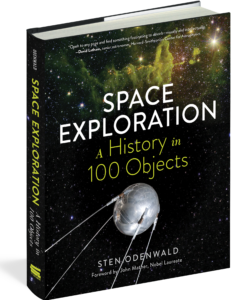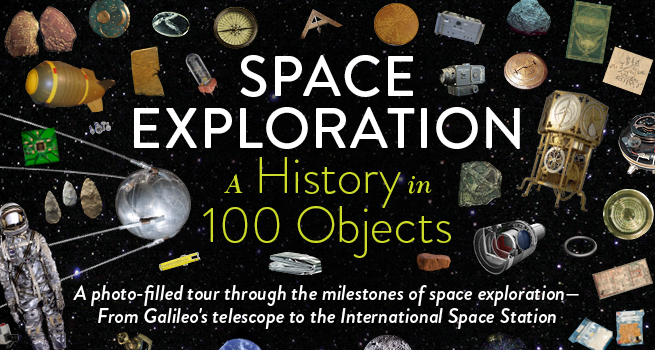 Within the pages of the eclectic pop-history Space Exploration—A History in 100 Objects, scientist and educator Sten Odenwald at NASA examines 100 objects that forever altered what we know and how we think about the cosmos. From Sputnik to Skylab and Galileo’s telescope to the Curiosity rover, some objects are iconic and some obscure—but all are utterly important.
Within the pages of the eclectic pop-history Space Exploration—A History in 100 Objects, scientist and educator Sten Odenwald at NASA examines 100 objects that forever altered what we know and how we think about the cosmos. From Sputnik to Skylab and Galileo’s telescope to the Curiosity rover, some objects are iconic and some obscure—but all are utterly important.
With this year marking the 50th anniversary of the first humans landing on the moon, there’s never been a better time to explore the exciting, beautiful, and downright strange objects and moments in our history, that, as Odenwald puts it, “represent the major scientific discoveries—and celebrate the human ingenuity—of space technology.” Read on for a special roundup of five remarkable objects from Sten Odenwald’s Space Exploration—A History in 100 Objects, available now wherever books are sold!
***
Object 1: The Blombos Ochre Drawing
The first step on our journey toward a deeper understanding of the cosmos must begin long before we ever developed the ability to reach space. The immensity of the universe goes so far beyond our tangible world that to even begin to wrap our heads around it, we had to learn how to transform our surroundings into symbols and abstractions. And since what we’d come to learn about the cosmos would exceed any single human brain or life span, to make any real progress in our exploration of space we had to learn to build a permanent body of knowledge by recording what we’ve learned and passing it on to the next generation of explorers.
In 1991, in the Blombos Cave—located about 190 miles east of Cape Town, South Africa—archaeologist Christopher Henshilwood and his team uncovered traces of Stone Age Homo sapiens inhabitants dating from as early as 100,000 BCE. The cave had been occupied multiple times, with each set of residents leaving behind shells, spear points, and some bone tools. But the most remarkable among these finds was discovered two decades later: a small stone flake, about 11/2 inches long and 1/2-inch wide, covered in distinct red lines. Henshilwood’s team eventually determined that the lines were applied using a kind of crayon made of ochre, a natural pigment, roughly 73,000 years ago.
As to what the lines actually meant to the people who made them, it’s impossible to say. But the crisscross markings seem intentional enough that many archaeologists interpret them as deliberate visual representation, making the stone the earliest known drawing done by a human hand.
Object 12: Hipparchus’s Star Atlas
Hipparchus is one of the ancient world’s most famous astronomers. He’s the one who discovered the phenomenon of precession, the way Earth’s axis gradually shifts over a period of about twenty-six thousand years, which shifts the alignment of the stars as we see them in the sky. But while he wrote at least fourteen widely cited books on astronomy and mathematics, his only surviving work is his Commentary on the Phaenomena of Eudoxus and Aratus. Everything else, and in particular his atlas of the sky, is lost.
Then, miraculously, in 2005 astronomer Bradley Schaefer at Louisiana State University announced that the Hipparchus star catalog had been hiding in plain sight—or at least a representation of it. A second-century Roman statue called the Farnese Atlas at the National Archaeological Museum in Naples, Italy, shows Atlas carrying a globe of the heavens on his shoulder. The globe depicts, in relief, forty-one constellations placed on a grid of circles representing the equator and the Tropics of Capricorn and Cancer. Through a careful study of the locations of the constellations, Schaefer was able to show that to accurately draw them, the sculptor would have had to use a star catalog and constellation guide from around 125 BCE—approximately the time when Hipparchus would have created his catalog. So there it was, an artistic rendering of Hipparchus’s long-lost work, held up for nearly two millennia by the arms of Atlas.
Object 26: The Clock Drive
If you spend a little while gazing at the night sky, one of the things you’ll notice is that the stars do not stay put. Over the course of hours, Earth rotates upon its axis, making a complete circuit every twenty-three hours, fifty-six minutes, and four seconds. That means that the view through a telescope will, maddeningly, show stars moving across the field of view. The idea of correcting for this apparent diurnal sky rotation was first applied to an armillary sphere in China by Su Song in 1094 using an ingenious water-clock mechanism. This technology was largely a novelty until the advent of large telescopes in the eighteenth century.
Early clock drives were “powered” by falling weights, but even after the invention of the electric motor in 1834, motors powerful enough to turn the gear works of clock drives weren’t available until the late 1800s. One of the major advances in clock-drive design occurred when computers became fast enough to keep up with the necessary calculations for tracking using a telescope mount that was non-equatorial “altitude-azimuth.” Virtually all modern telescopes larger than about nine feet now use Alt-Az mounts driven by computers and stepper motors, which continuously compute the correct azimuth and elevation for a target and update the telescope pointing several times a second or faster.
Thanks to these essential devices, spectroscopic and photographic studies were feasible for faint objects that required hours of exact guidance at the eyepiece to track. Without clock drives, either mechanical or electronic, most of the observations for which twentieth- century astronomy is famous, such as the discovery of the expanding universe and the photographing of surface details of distant planets, would have been impossible.
Object 59: Sputnik
The events of October 4, 1957, shocked the world. Seemingly out of nowhere, the former Soviet Union launched Sputnik 1, a 184-pound, 23-inch-diameter satellite, into orbit. Every ninety-eight minutes, the signal from its one-watt transmitter could be heard near frequencies of 20 and 40 megacycles (called megahertz today) by any radio transmitter on Earth. Operation Moonwatch had over 150 stations manned by amateur astronomers watching for the faint starlike satellite as it raced across the twilight sky. Amateur radio operators of the American Radio Relay League, meanwhile, listened to their radio receivers for the distinctive beep-beep-beep.
From the vantage point of today, we imagine that this one event triggered the massive space race between the United States and the USSR, but in fact President Dwight D. Eisenhower, although knowledgeable about the USSR’s progress via U-2 reconnaissance planes, was by some accounts dismissive of the event. Even the USSR did not use it initially in its propaganda. Eisenhower greatly underestimated the reaction of the American public, however, who were shocked by the launch of Sputnik 1 and by the televised failure of the US’s Vanguard Test Vehicle 3 launch on December 6, 1957. Only the successful Explorer 1 spacecraft, launched on January 31, 1958, got the United States back in the game.
Sputnik 1 lasted twenty-two days before its battery power ran out, and it went on to orbit for seventy-one more days before it burned up in the atmosphere on January 4, 1958. During its short life, the upper-atmosphere drag on the satellite could be measured by noting the satellite’s orbital speed change at perigee. This gave scientists valuable information for the first time about the upper atmosphere’s density and its variation with altitude. Also, by studying the frequency shift and propagation of the radio signals at 20 and 40 megacycles, the properties of the topside ionosphere (an ionized outer layer of the atmosphere) could be measured from space.
Object 72: The Hasselblad Camera
In October 1962, astronaut Walter Schirra brought a Hasselblad 500C camera into space with him on the Mercury mission and snapped the first space photographs. Since then, Hasselblads have been the NASA space program’s favorite still-frame cameras. Manufactured by the Victor Hasselblad AB company, based in Gothenburg, Sweden, the medium-format cameras were used extensively in the Gemini, Apollo, and Skylab programs, and some of the most iconic images of outer space have been taken with them.
On Christmas Eve 1968, Apollo 8 astronaut William Anders took the famous image entitled Earthrise with a 70 mm Hasselblad 500EL fitted with a 250-mm telephoto lens. He had just completed an extensive photography session of the lunar surface and the camera was loaded with a fresh film cartridge: custom Ektachrome film developed by Kodak. As with all of the Hasselblad cameras used by NASA, Anders’s 500EL was specially designed for use in space. Its silver color helped with thermal control when exposed to the space environment.
In a frantic few seconds, Anders recognized the beauty of the evolving scene he was seeing from the window of the Apollo command module and quickly snapped a sequence of stills, of which Earthrise was the most perfectly focused and artistically framed. More than just a lovely photo, it went on to capture the imagination of millions of humans back on Earth, providing inspiration for the budding environmental movement and future Earth Day celebrations.
***
Get your copy of Space Exploration—A History in 100 Objects by Sten Odenwald now wherever books are sold!





